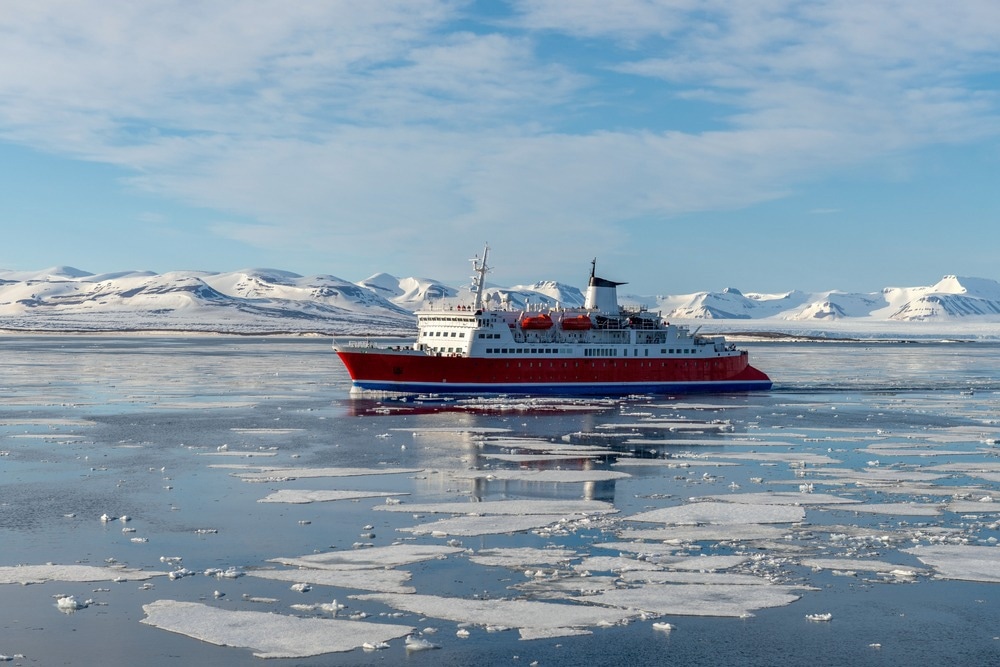A recent study published in Marine Science and Engineering has accumulated in situ data on chlorophyll-a concentration and sea reflectance. The "Akademik Ioffe" research vessel collected data on the sea reflectance coefficient during a cruise in the Kara Sea outside the Arctic Circle. A total of 28 observations of sea reflectance were obtained under various circumstances, from estuarine zones to open oceans.
 Study: Advantage of Regional Algorithms for the Chlorophyll-a Concentration Retrieval from In Situ Optical Measurements in the Kara Sea. Image Credit: Alexey Seafarer/Shutterstock.com
Study: Advantage of Regional Algorithms for the Chlorophyll-a Concentration Retrieval from In Situ Optical Measurements in the Kara Sea. Image Credit: Alexey Seafarer/Shutterstock.com
Importance of Chlorophyll-a Concentration
Chlorophyll-a content is one of the most significant elements of marine ecology that can be determined from satellite photography. It is frequently employed to determine the ocean's radiation balance or primary production. It can also be used as a contrast material to study ocean dynamics.
Chlorophyll-a Concentration for Monitoring Ecological Condition of Kara Sea
This study examines numerous methods used to determine the chlorophyll concentration in the Kara Sea using satellite and in-situ remote sensing reflectance. The Kara Sea is a fascinating study subject due to its significant anthropogenic influence.
The Arctic region's rapid development increases pressure on the ecosystem. The chlorophyll-a concentration (one of the crucial indicators) can be used to monitor the ecological condition of the area.
Limitations of Algorithms for Obtaining Chlorophyll-a Concentrations
Geographical features like rivers that transport suspended sediments and boost water productivity are not determined by the algorithms used to regulate chlorophyll concentrations from satellite data.
The distribution of chlorophyll-a in the surface water layer and the composition of seawater can both be altered by the influence of river runoff or glacier melting. All of this results in the inaccurate performance of satellite algorithms.
Strategy to Enhance Algorithms for Chlorophyll-a Concentration
The development of regional algorithms based on local datasets that automatically regulate the distinctive characteristics of the researched location is one technique to enhance algorithms for chlorophyll-a concentration.
The regional algorithms produce more precise readings of chlorophyll concentration. Regional algorithms are developed based on the in situ data of the sea reflectance collected by contact measurements. Direct in situ measurements of chlorophyll-a in samples validate, construct, and check regional bio-optical models.
Limitations of In-situ Measurements
Satellite images synchronous with in situ observations are challenging to capture due to persistent cloudiness over the Kara Sea region. There is 80–90% cloud coverage on average from June to October. OLCI, MODIS, and VIIRS are needed to be used for computations with local algorithms because they have a wide variety of bands in the visible spectrum. The breadth between the channels prevents Landsat from serving this function.
The atmospheric correction presents another challenge for the remote estimation of chlorophyll concentration in the Arctic region. The assumption that radiative transmission occurs in a plane-parallel fashion, which is true for solar zenith angles, is the foundation for most atmospheric correction techniques.
Development of In Situ Data on Sea Reflectance by Adaption of Regional Algorithms
The sole flexibility available to the typical atmospheric correction technique is to adjust its aerosol model to match the observations. A general atmospheric correction technique POLYMER (POLYnomial-based approach designed for the atmospheric correction of MERIS data) without a particular aerosol model can be used for this purpose. Adding corrective parameterizing for the characteristics of seawater is another option.
Korchemkina et al. presented in situ data on sea reflectance for the Kara Sea throughout the summer and fall of 2021. The researchers compared in situ data with satellite data to demonstrate the effectiveness of atmospheric adjustment for Polar Regions.
The retrieval of the chlorophyll-a concentration in the Kara Sea can be greatly improved through adaptation and further development of regional algorithms. In this study, two such algorithms (one semi-analytical and one empirical) are presented.
Research Findings
In this study, new data on the concentration of chlorophyll and sea reflectance were gathered. These data were compared with satellite data from the VIIRS, MODIS, and OLCI sensors. The comparison demonstrated that inflated remote sensing reflectance values were seen in short-wave channels, which can be caused by glitches in the functioning of atmospheric correction algorithms.
Additionally, chlorophyll-a concentrations were determined by the standard and regional methods based on satellite data of the remote sensing reflectance. The researchers demonstrated that regional algorithms and typical satellite sensors used to remote sense data in the Kara Sea cannot yield accurate chlorophyll concentrations, necessitating the adjustment of atmospheric correction methods.
In situ reflectance data were also processed using regional algorithms K17 (empirical) and MHI (semi-analytical), as well as global models GIOP and OCx. It was determined that OCx was not appropriate for such complicated water conditions and that GIOP required significant tuning by local bio-optical properties.
With a little fine-tuning, it was demonstrated that the regional Black Sea algorithm MHI can be used in both oligotrophic and eutrophic waters in the Kara Sea. The regional algorithms K17 and MHI exhibited a high correlation with in situ chlorophyll-a concentrations (0.6 and 0.76, respectively) and had relatively low RMSE and MAPE chlorophyll-a concentrations.
Reference
Korchemkina, E., Deryagin, D., Pavlova, M., Kostyleva, A., Kozlov, I. E., & Vazyulya, S. (2022). Advantage of Regional Algorithms for the Chlorophyll-a Concentration Retrieval from In Situ Optical Measurements in the Kara Sea. Journal of Marine Science and Engineering, 10(11), Article 11. https://www.mdpi.com/2077-1312/10/11/1587
Disclaimer: The views expressed here are those of the author expressed in their private capacity and do not necessarily represent the views of AZoM.com Limited T/A AZoNetwork the owner and operator of this website. This disclaimer forms part of the Terms and conditions of use of this website.